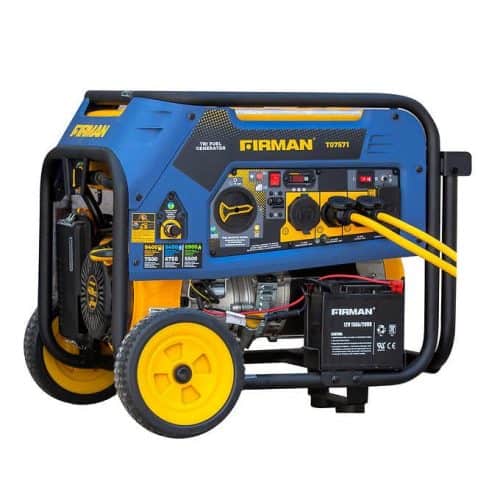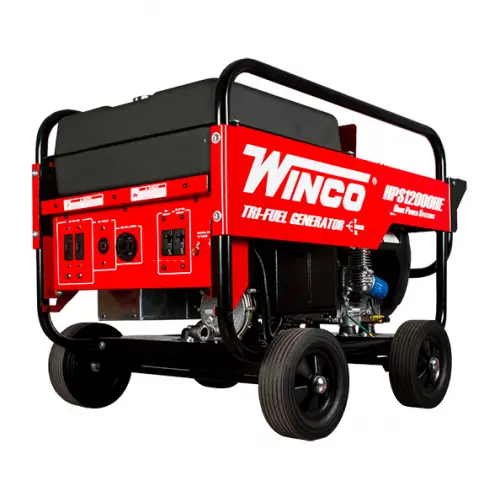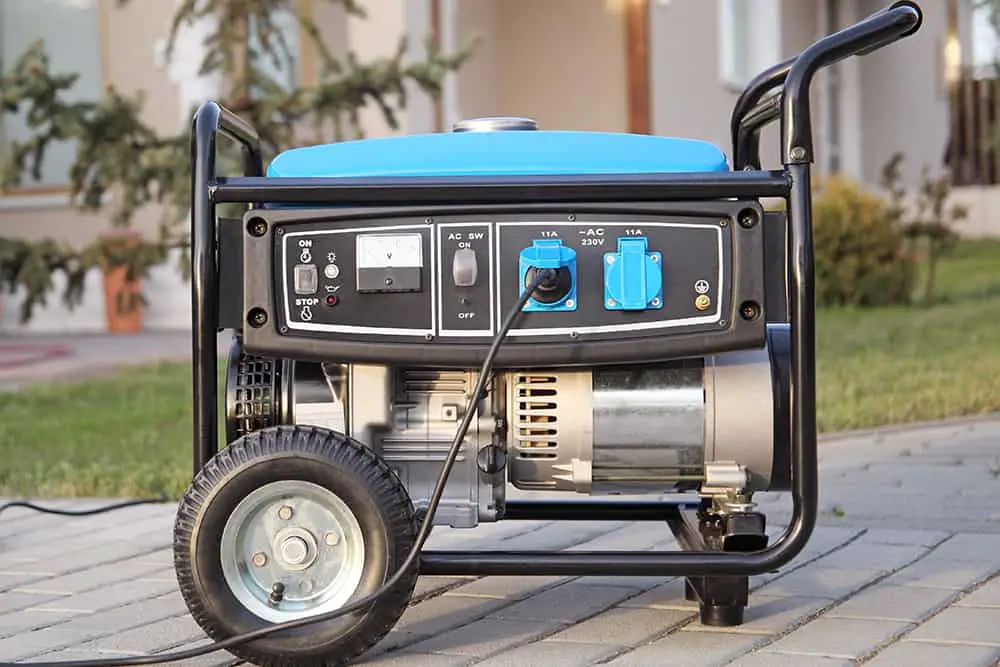As an affiliate we may earn from qualifying purchases.
A powerful tri fuel generator offers the ultimate in convenience and readiness when it comes to powering essential appliances on the go or during a power outage.
Whereas dual fuel generators only run on gasoline or propane, a tri fuel generator can run on natural gas as well.
That’s a big deal in an emergency power outage, and not only because you’re adding a third fuel option to your generator’s repertoire when gasoline or propane is hard to find. Many houses already have built-in natural gas lines that continue to work even when the electrical grid is shut down, so your tri fuel generator can tap directly into that virtually limitless supply of fuel.
In addition, a tri fuel generator is simply convenient because they offer such versatile fueling. If you find you need to take the generator on the road, like for a road trip, you can use gasoline or propane. But if you’re using the generator around your home’s yard, you can once again tap into your natural gas line and never have to worry about running out of fuel.
So, why are dual fuel generators often a more popular option than tri fuel generators?
One of the main reasons is that tri fuel generators come at a price premium. If you’re not worried about a power outage or don’t already have a natural gas line running to your home, then that extra money up front might not be worth it.
Another reason is that natural gas is the least efficient generator fuel since it’s not very energy-dense. Because of that, most tri fuel generators put out less wattage when running on natural gas than when running on gasoline or propane.
But, if your home has a natural gas line, don’t let the sticker shock or lower wattage scare you away. A tri fuel generator is still one of the best ways to prepare for an emergency and you can still reap the benefits of fueling with propane or gas. Plus, natural gas is cheaper than propane or gasoline.
With all that in mind, let’s take a look at my favorite tri fuel generator, the Smart Generators Pramac.
Please note, that Tri Fuel Generators are hard to come by. The following model from Pramac shows up from time to time online. If you can’t find a good option – you could consider using a Tri Fuel Conversion Kit as mentioned below.
Table of Contents
Best Tri Fuel Generators
Firman H07552 7500W Running/9400W Peak Tri Fuel Generator

Capable of running continuously for 12 hours at half load, Firman’s H07552 is a tri -fuel gennie that boasts 7500 running watts. That’s more than enough to keep your home running in an emergency or as a business owner’s backup for power outages!
You’ll find five AC outlets on its compact, well organized control panel: dual 120V, 20 amp GFCIs; 1x 120/240V 30A; 1x 120/240V 50A and 1x 120V 30A L5-30R. The twist lock L1430R is especially useful, perfect for hooking it up to your breaker box.
Also found on the panel is a 3 in 1 Data-Minder display, which monitors useful information such as voltage, frequency and hours in use. The handy fuel selector switch allows you to quickly flick between each of the individual supply options.
Rated at approximately 74 dB, it’s far quieter than some of the competing units around; that said, although it’s marketed as portable because of the attached wheel kit, it’s not actually that easy to relocate, given its hefty 212lb weight.
Safety features include an integrated automatic shut-off function when low oil is detected, as well as an internal circuit breaker system to protect you and the device in the event of power overload. Use the Firman in your home in total safety!
Pros:
- Five AC outlets to choose from – a versatile range
- Electric starter and conventional pull-start mechanism, batteries included
- EPA approved, CARB compliant – legal in all 50 states, including California
Cons:
- Not recommended for use with sensitive electronic devices (has a high Total Harmonic Destruction rating of <25%)
Winco HPS12000HE Tri-Fuel Portable Generator

Ideal for providing backup power in your home, Winco’s electric start tri-fuel generator is a portable model that switches on with the turn of a key, so you’ll be up and running in no time – a battery rack and cables are provided as part of purchase.
An industrial grade, high quality Honda V-Twin 4-Cycle engine utilizes an OHV design, to offer the maximum transfer of power and better than average efficiency. Paired with a tri-fuel carburetor and gas regulator, it’s a highly versatile unit.
Thanks to Honda’s patented Oil Alert warning system, the engine is automatically shut down if the oil should reach an inoperable or unsafe level – this ensures you won’t experience any engine damage as a result of overheating.
The 120/240V 30 amp and 60 amp receptacles are protected by a capacitor-regulated voltage, allowing for less than 5% Total Harmonic Distortion (THD) – this keeps any sensitive electronics protected from a power surge.
You can easily hook up this tri fuel generator to the L13-40 outlet as this allows for easy connection with a manual transfer switch. A 45 amp mainline circuit breaker also provides additional overload protection.
Pros:
- EPA approved, 15-gallon steel fuel tank and gauge – carbon emissions are completely eradicated
- Steel gauge cradle with protective powder coat finish and a four-wheel flat free dolly makes it incredibly portable
- 100% lead tested prior to shipping
Cons:
- Can only be started using the supplied electric system – not suitable for modifications
Runner up
Hutch Mountain Tri-Fuel Generator Conversion Kit (Honda EU22000i compatible) – Best Value
Enabling you to choose between three fuel options – natural gas, gasoline or propane – the Hutch Mountain tri fuel generator conversion kit guarantees you have power when you absolutely need it. Stay prepared in an emergency!
Ensure your fuel has an endless shelf life and prevent clogged carburetors by using clean propane or natural gas over gasoline – this kit uses the original Honda EU no-drill system, and the carburetor is not drilled or modified in any way.
Recognized as the only kit available right now that will not cause airflow restriction, you’ll find it offers the best performance and fuel efficiency. On a standard propane tank, you’ll find it offers more than 20 hours of run time – perfect for emergencies.
Pros:
- Runs super quietly, thanks to Honda’s power inverter technology
- No modifications are necessary, allowing you to install and disassemble with ease
- An authentic no-drill Honda supported conversion, arriving 90% pre-assembled
Cons:
- Not technically CARB compliant
RUNNER UP
Nashfuel Tri-Fuel Subaru EX27 EX30 EX40 Conversion Kit (compatible with all EX30D engine generators)
Ready to help you convert your Subaru EX27, EX30, EX40, EH, or any EX30D engine-ran generator, this tri fuel kit is also a Nashfuel model – a highly recommended brand that is renowned for its quality amongst the gennie community.
Once installed, this kit will allow you to run your generator on low or high pressure propane, low pressed natural gas and gasoline. Choose whichever fuel suits your preference, and burn as cleanly as possible.
Thanks to their clever, unique venturi design, this kit can be installed without the need for modifications on the majority of compatible generators. Each component has been manufactured in the USA, so you know you’re getting the very best.
Pros:
- Versatile range of fuel options available to you
- Easy installation with no modding required (for most generators)
- Reliable components manufactured in America
Cons:
- On the more expensive side for just a conversion kit

Best Tri Fuel Generator Buying Guide
How to Convert a Dual Fuel Generator Into a Tri Fuel Generator
If you already have a dual fuel generator, it’s not hard to convert it into a tri fuel to be better prepared for an extended power outage.
Many manufacturers sell conversion kits to help you through the process and provide you with everything you need.
The most important parts of any conversion kit are the on demand regulator, which only allows fuel to flow when there is suction from the engine, and the carburetor adapter that allows your generator to safely use natural gas.
Most conversion kits also come with spacers, gaskets, and any other hardware you need to bolt the carburetor adapter onto your generator. However, you may need to purchase gas lines and fittings to connect your generator to your home’s natural gas line separately.
The first step in installing your carburetor adapter is to remove your air filter housing from in front of the generator’s carburetor. When you do this, keep track of the air filter and gasket as you’ll need them when putting the generator back together.
You’ll now need to add some space in front of the carburetor. Depending on the hardware included in your conversion kit, you may have a spacer or just a set of stud extenders. In either case, attach them onto the bolts sticking out of the carburetor where the air filter housing was previously located.
Now you can slide the carburetor adaptor onto the bolts. It’s a good idea to use Teflon tape over the threads to make sure you’ll be able to slide the adapter back off if you ever need to, as well as to ensure there is no empty space in the threads.
When finished, re-attach the air filter housing, making sure that you replace the gasket onto bolts so that there is no open space where air could get in behind the filter housing.
Now it’s time to attach the on demand regulator to the generator. With most conversion kits, you need to drill into your generator to bolt the regulator directly to the frame. Make sure you don’t drill into the fuel tank, and make sure the regulator attachment is pointing downward.
Alternatively, you can use custom hardware to mount the regulator to the frame without drilling.
Attach a fuel hose from the outflow of the on demand regulator to the carburetor adaptor. If there is only one hose clamp, put it on the outflow of the on demand regulator.
When the time comes to connect your generator to natural gas, you’ll need an additional gas hose to connect the inflow power of the on demand regulator to the natural gas line of your home. This is where having a set of easy to connect adapters can make getting your generator up and running much faster during a power outage.
You’ll also need to adjust the set screw on your on demand regulator. Unscrew the set screw most of the way and start up your generator, fueling it off your home’s natural gas line. The engine should run, but will sound jumpy. Slowly screw in the set screw until the engine catches and runs consistently, then use the included bolt to fix the set screw in place.
Tri Fuel Conversion Kits For Generators
Your conversion kit will largely govern how easy or difficult the process of converting your dual fuel generator to tri fuel will be.
The most important thing to keep in mind when choosing a tri fuel conversion kit is that it needs to match your generator. If you conversion kit isn’t designed to work specifically with your make and model of generator, you’re likely to end up with space behind the air filter or a carburetor adapter that won’t work with your carburetor.
There are a number of tri fuel conversion kits available from Amazon, which range in price from less than $50 to more than $200. Remember that you get what you pay for – more expensive conversion kits are typically manufactured to a higher standard, use higher quality parts, and come with more of the hardware you need to complete the conversion
NashFuel is my favorite when it comes to tri fuel conversion kits (link here). They make a variety of kits for most generator makes and models, including Honda, Champion, Briggs & Stratton, and Predator.
HIPA makes far less expensive natural gas conversion kits, but these are much more obtrusive on the exterior of your generator and require more technical knowledge because they come with very little instruction.
Finally, Hutch Mountain is a premium supplier of natural gas conversion kits. These kits are largely similar to those from NashFuel, but are manufactured to a slightly higher specification and come with a greater degree of technical support.

Frequently Asked Questions
How do I know where to bolt in my on demand regulator?
You can bolt in your on demand regulator to anywhere on the frame of your generator, as long as you don’t drill through any vital components. The most important and obvious component to avoid drilling through is the gasoline fuel tank.
In general, you should place at least two bolts to secure your regulator. However, be wary of placing more, as this can make the exterior of your generator look like swiss cheese and allow water to seep inside if it’s outside in the rain.
Can I remove the natural gas conversion later?
Yes. Removing a natural gas conversion kit is simply the reverse of installing it.
The only thing that can’t be undone during the conversion is the bolt holes drilled into the frame of your generator.
If you think that you may remove the conversion at a later date, you can use custom hardware to mount the regulator onto the frame handle rather than onto the generator itself.
What if I have space behind my air filter during the conversion?
If you find that you have space behind your air filter housing after putting a spacer between it and your carburetor adapter, you either have the wrong conversion kit or a poorly manufactured conversion kit. This is a problem because it will allow unfiltered air into your carburetor.
Don’t worry, though. You can eliminate this space by adding in a custom rubber or metal gasket. You’ll need to cut this to the same external size as the spacer, but with dimensions that plug the space behind the air filter housing.
What is the best gas for a generator?
The best gas for a generator is natural gas as it is widely available for all kinds of generators and is also cost effective. It is the most popular gas used for home-based generators but it is important to note that it does carry less energy than other kinds of gas.
Always double check what gas can be used in the instruction manual that you receive with your generator. There may be particular gas that you can’t use on specific generators so it’s always best to be sure before you fill the generator up.
Is it cheaper to run a generator on gas or propane?
Overall, it is cheaper to run a generator on gas than propane. Propane costs less initially but as it has lower energy, this means you’ll be spending more in the long run on propane than gasoline.
Also, gasoline tends to be more widely available so if you were in a tight spot and in need of refilling your generator then it is always best to go with gasoline.
It is all dependent on what you are using your generator for and how often you use it that needs to be taken into consideration when deciding whether to fill it up with propane or gas.
For more info on propane consumption, see out post on how much propane a generator uses where we break down wattage and tank sizes.
What size generator do I need for my house?
If you are purchasing a generator for a house, you will need to get a high powered generator.
You should be looking at a generator with around 5,000-7,500 watts to power the larger appliances in the household such as the washing machine, refrigerator and freezer.
The higher wattage count means that you can run all of the appliances at once with peace of mind.
In comparison, a suitable generator for an RV would have around 3,000-4,000 watts to run all the appliances.
The reason the wattage is so high for a household is because you have to consider all the appliances you have as well as the constant power that those appliances would need.
For example, a refrigerator and freezer would need to be powered 24/7 but a washing machine can be disconnected when it is not in use.
Can I leave gas in my generator?
Simply put, it isn’t advised to leave any gas in your generator when storing it away. This means that you are reducing any risk of damage to the generator.
If you do insist on leaving the gas in the generator then it is best to store it with a stabilizer.
This will prevent any potential corrosion from happening. With a stabilizer, you can leave the gas in your generator for several years but without it, you can only leave the gas in the generator for several months before any damage will occur.
If you do plan to add a stabilizer then add the gas and run the engine for several minutes before turning it off and storing it away.
Conclusion
Tri fuel generators offer convenience and readiness when it comes to powering your home through an extended power outage.
If you’re in the market for a new tri fuel generator, the Smart Generators Pramac 7,500-watt generator is my favorite. Alternatively, if you already have a dual fuel generator, it’s easy to use a conversion kit to turn it into a tri fuel generator.

when converting a duel fuel to a tri fuel, the existing carburetor is set up to accept propane, can you just add a tri fuel demand regulator and connect the existing hose that goes from the carburetor to the existing propane regulator to the new regulator?
I have never tried. Here is the best answer I could find.
https://www.instructables.com/id/Multi-Fuel-Generator-Gas-Propane-NG/
I tried; it works but not exactly the same as propane or gasoline.
First I simply ran a line from my NG outlet to the built in propane inlet on the generator and it worked but only with the choke set to start. Moving into run would stop the generator.
Added a Garretson regulator with a load block and wound up with basically the same results.
Took the built in propane regulator and solenoid out of the picture by connecting directly into the gas inlet on the carburetor; no change.
Even tried increasing the supply hose from 3/8 to 1/2 since my outlet is 1/2 and no change.
Runs great with the choke set to start but set to run is a mystery to me at this point.
Mystery to me too…
This actually answered my question, thanks!
No worries, happy to help!